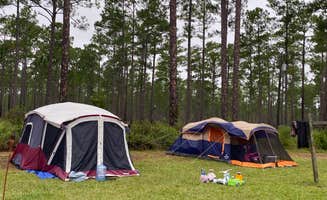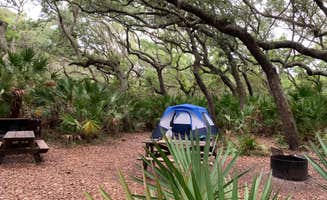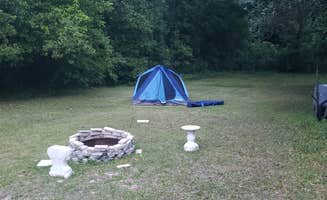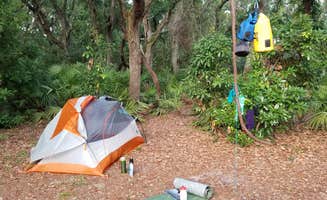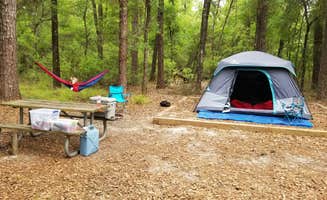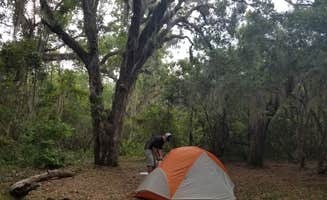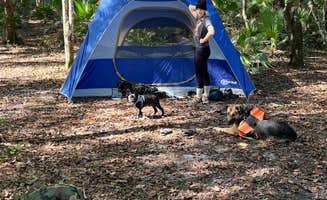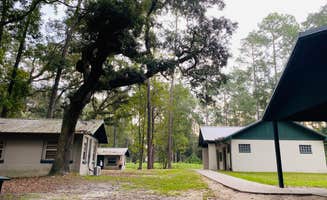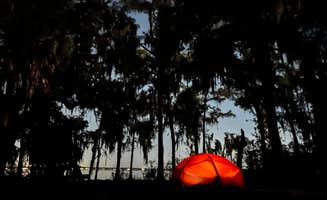Tent camping near Callahan, Florida offers access to brackish river systems, coastal barrier islands, and inland forests within a 50-mile radius. The region averages 221 sunny days per year, creating favorable conditions for extended camping seasons. Summer temperatures frequently exceed 90°F with high humidity, requiring campers to prepare for heat management at primitive sites.
What to do
Biking island trails: Cumberland Island National Seashore provides both paved and sandy paths for exploration. "We used a wagon to carry to our stuff (and the kid) but the road terrain was pretty rough. If anyone is planning to bike on the island, I'd recommend they ensure their bicycle can handle that sort of surface," notes a Sea Camp Campground visitor.
Kayak the waterways: Launch directly from select campsites at Dutton Island Preserve where "it has its own little spot to launch kayaks/canoes from. We were able to get in the water as soon as the conditions looked perfect." Another camper adds that "if you find yourself on the tip of Dutton Island Preserve, in just the right location (ideally floating in a kayak pointed southwards), you'll catch an amazing view of this northernmost city in Florida."
Historical exploration: The Cumberland Island ruins provide historical context for the region. "The ruins of an 1800s mansion built by a Carnegie that burned in 1959 is also one of those mysterious places that conjure emotions and kick the imagination in gear," shares one camper. Early morning or late afternoon provides best lighting conditions for photography of the structures.
What campers like
Wildlife viewing opportunities: The diverse ecosystems support remarkable animal encounters. "Palm trees filling in the canopy of the largest stand of live oaks left in U.S. that all have spanish moss hanging in them like no movie production set designer could ever replicate make you feel like you time jumped to a jurassic age. Armadillo are scurrying around minding their own business dragging their noses through the sandy dirt eating ant trails," reports a visitor at Sea Camp Beach.
Morning beach solitude: Early risers find exceptional coastal privacy. One camper notes, "Walking out on beach from tent every morning just to watch the sun rise over the Atlantic ocean while crab boats chug along being part of the scenery as the sun rises, you are first and only person on an 18 mile long beach until around 10 a.m."
Temperature differences under tree canopy: Natural cooling provides relief during hot months. "It was a hot time of year but under the canopy of the live oak trees where the tent sites are located was easily 10+ degrees cooler than elsewhere," according to a Cumberland Island camper who visited in June.
What you should know
Ferry logistics and preparation: Cumberland Island access requires careful planning. "Whatever supplies you choose to go camping with, you will need to 'wheel it on' the actual ferry, which likely requires a hard examination of what really is essential versus 'nice-to-have'," explains a Brickhill Bluff camper. The ferry from St. Marys costs approximately $15 per person with additional charges for bicycles.
Seasonal bug considerations: Insect protection strategies vary by location and season. A Hickory Hill visitor warns, "Unfortunately, no amount of bug spray could deter the mosquitoes in June. We had a million bug bites and tent camping in this humidity was uncomfortable. Elsewhere on the island was not nearly as bad for ticks and mosquitoes."
Water requirements: Water availability varies significantly between campgrounds. At primitive sites, "There is no potable water at Yankee Paradise. You will either need to fill your water up from a spigot at Plum Orchard or walk a bit down the parallel trail to find a pump." Campers should plan to carry sufficient water or filtering equipment.
Tips for camping with families
Consider accessibility needs: Some campgrounds offer shorter hiking distances for families with younger children. At Jennings State Forest, "We hiked the beach pioneer trail and really enjoyed ourselves. The campsite is about a mile in and has a picnic table and fire ring. There is a stream nearby for water."
Unique sleeping arrangements: Alternative accommodations can enhance family camping experiences. "We stayed here for a night and loved it. There were short trails, a kayak/canoe launch, a pool, dock, fishing, and clean amenities. We had the Squirrel Run cabin which had AC and 6 bunk beds. Which was great for our family of 6," reports a visitor to Camp Chowenwaw Park.
Educational opportunities: Ranger programs provide valuable learning experiences. "The resident volunteer led an info session on armadillos which was educational and fun and really added value to our trip," notes a family who visited Cumberland Island. These programs typically run 30-45 minutes and occur near visitor centers.
Tips from RVers
Limited RV access: Most tent camping destinations near Callahan have minimal RV facilities. Jennings State Forest Hammock Campground does provide some RV accommodation, though one visitor notes the site is "primitive" with basic amenities and "the place is just gorgeous for being just outside of the Jacksonville area."
Weather and road conditions: Unpaved access roads can present challenges following rain. "The dirt roads that lead in were very muddy. Small cars may have a hard time in rainy season," warns a Dutton Island Preserve camper. This applies even more significantly to larger vehicles and RVs attempting to access these areas.
Electrical considerations: Most primitive sites lack hookups, requiring self-contained power solutions. Campgrounds with electric hookups typically offer 30-amp service, with 50-amp connections available at select locations like Jennings State Forest where visitors note "there are designated camping sites and walk in camping sites."


